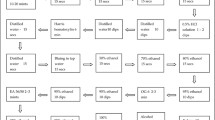Abstract
Introduction
Conventional Pap smear is a commonly done screening test for cervical cancer. Accurate interpretation depends upon the specimen adequacy which is considered to be the single most important quality indicator of “The Bethesda System (TBS)”.
Purpose
To audit specimen adequacy and compare results based on 2014 TBS.
Study Design
Retrospective audit from 1 April to 31 December 2015.
Methodology
Data was collected from case notes and Pap smear reports.
Results
A total of 146 Pap smears were done during the study period. Majority of the women (34 %) were between 41 and 50 years. Fifty-five per cent had a small family size of two children. Seventy-six per cent were premenopausal while 34 % were post-menopausal. Transformation zone/endocervical component (TZ/EC) was seen in 87 % of smears. Blood was seen in 2.7 % and inflammatory cells in 59.6 % of smears. All smears were satisfactory for interpretation by the cytologist. In the final interpretation, atrophic smears were seen in 2/146 (1.4 %), low-grade epithelial abnormality and high-grade abnormality were seen in one smear each (0.7 %). Colposcopy and directed biopsy were normal in both. A total of 43.8 % were normal. A total of 53.4 % were inflammatory.
Conclusions
In this audit, 100 % smears were satisfactory for interpretation and above the literature standard of 99.5 %.
Similar content being viewed by others
References
Fact Sheet—Cervical Cancer. National Institutes of Health, Updated Oct 2010.
Aparna N, Vasavi B, Harendra Kumar ML, Sapna M. An audit of Pap smear cytology. J South Asian Fed Obstet Gynaecol. 2011;3(3):121–4.
Nayar R, Wilbur DC. The Pap test and Bethesda 2014. Acta Cytol. 2015;59:121–32.
Crasta JA, Chaitra V, Simi CM, Correa M. An audit of cervicovaginal cytology in a teaching hospital: are atypical glandular cells under recognised on cytological screening? J Cytol. 2009;26:69–73.
Davey DD, Nielsen ML, Naryshkin S, et al. Atypical squamous cells of undetermined significance: current laboratory practices of participants in the college of American Pathologists Inter-Laboratory Comparison Program in cervicovaginal cytology. Arch Pathol Lab Med. 1996;120:440–4.
Ilter E, Midi A, Halilogulu B, et al. Comparison of conventional and liquid based cytology, do the diagnostic benefits outweigh the financial aspect? Turk J Med Sci. 2012;42(sup1):1200–6.
Birdsong GG, Davey DD. Chapter 1: Specimen adequacy. In: The Bethesda system for reporting cervical cytology, definitions, criteria and explanations. Switzerland: Springer International Publishing; 2015. p. 1–28.
Weinstein LC, Buchanan EM, Hillson C, et al. Screening and prevention: cervical cancer. Prim Care. 2009;36:559–74.
Elias A, Linthorst G, Bekker B, et al. The significance of endocervical cells in the diagnosis of cervical epithelial changes. Acta Cytol. 1983;27:225–9.
Arbyn M, Anttila A, Jordan J. European guidelines for quality assurance in cervical cancer screening. 2nd ed, chapter 3. Lyon: International Agency for Research on Cancer; 2008. p. 87–88.
Davey DD, Chair R, Austin M, et al. American Society of Colposcopy and Cervical Pathology patient management guideline. Am J Clin Pathol. 2002;118:1–5.
Davey DD, Cox T, Austin M, et al. Cervical cytology specimen adequacy-patient management guidelines optimizing specimen collection. J Low Genit Tract Dis. 2008;12(2):71–81.
Dasari P, Rajathi S, Kumar SV. Colposcopic evaluation of cervix with persistent inflammatory Pap smear: a prospective analytical study. CytoJournal. 2010;7:16.
Kelly BA, Black AS. The inflammatory cervical smear: a study in general practice. Br J Gen Pract. 1990;40(335):238–40.
Author information
Authors and Affiliations
Corresponding author
Ethics declarations
Conflict of interest
All authors declare that they have no conflict of interest.
Rights and permissions
About this article
Cite this article
Digumarti, L., Nayak, S.S. & Nutakki, R. An Audit on Adequacy of Pap Smears. Indian J Gynecol Oncolog 14, 38 (2016). https://doi.org/10.1007/s40944-016-0067-z
Received:
Revised:
Accepted:
Published:
DOI: https://doi.org/10.1007/s40944-016-0067-z




